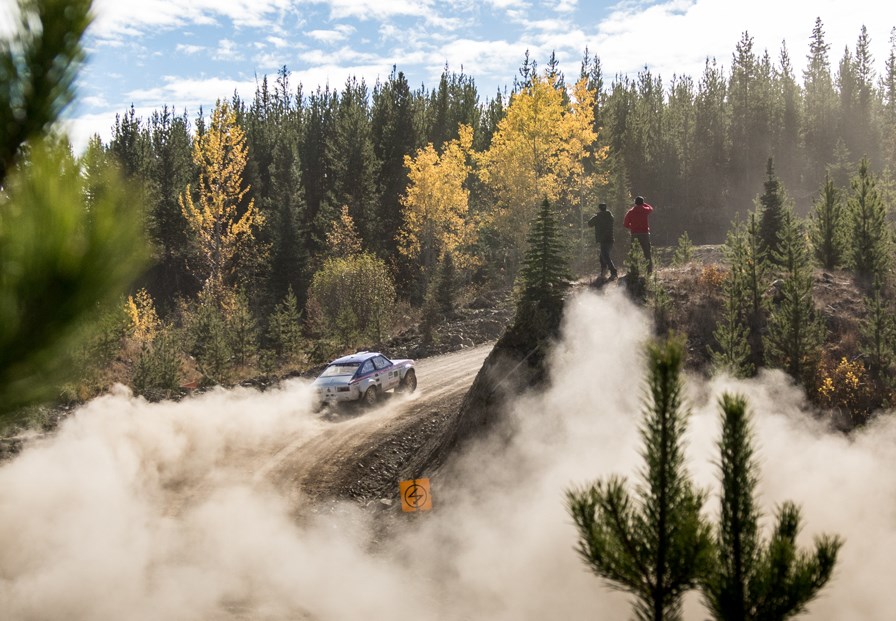Drifting! It's what the youths are into these days. And, if you've read the recent story on the driver who unfortunately and also a Mercedes, then perhaps it may seem something of an irresponsible activity. Because it is, if you do it wrong.
Drifting is a great deal of fun, and I have done a fair bit of it. Allow me to walk you through a simple Q and A regarding the rules on drifting.
Q: May I drift my car on an enclosed racing circuit?
A: Yes!
Q: May I drift my car on the public roads?
A: No!
Q: May I drift my car on a gravel surface during a sanctioned rallycross?
A: Yes!
Q: May I drift my car in this school zone?
A: No! Give your head a wobble, you utter spoon.
Q: May I drift my shopping cart around Save-On-Foods while softly humming the theme tune to the popular animated drifting series Initial D?
A: Well. You might get in trouble for that one. Watch out for the soup can pyramids and don't tell your mother.
Almost everyone reading this column has done a bit of mini-drifting in their day, intentional or otherwise. It's an essential part of becoming a good driver: the sense of losing control of a vehicle, then recovering it safely. Especially in snowy conditions, or on loose surfaces, educating yourself on how to stop your vehicle from going into a spin is a useful skill to have.
Sometimes called powersliding, a drift is pretty much exactly what it sounds like. If the tail of your car is coming around and you simply stomp on the brakes, weight is transferred forward, and the car will spin. If you continue to feed in power while turning the steering wheel in the direction you are sliding, then the car won't spin, and you'll recover control.
Obviously inducing a loss of control on purpose is a very bad idea and should not be done outside of a closed course. Further, knowing when it's time to slow down and respect the weather conditions is a key part of driving responsibly, as is not shutting off traction control. You are not the lovechild of Ayrton Senna and a McLaren, and stability aids are there for a reason.
However, driving is full of the unexpected, so you should know how to countersteer in the event you hit a patch of ice or similar. Some driving schools will take you out to a wet skidpad and let you have at it. Having more understanding of car control is always a good thing, unless you abuse that knowledge.
Let me tell you about a satisfying drift I once pulled off. It was at the DirtFish rally driving school down in Washington, which I highly recommend. On the third day of instruction of the intermediate course (I'd done the standard course several times), I lined up a perfect slide around a tricky hairpin corner, threading the Subaru STI out into a perfect four-wheeled drift, flinging gravel and hammering through the turn.
“Yes!” I shouted in triumph.
“Pay attention!” shouted the instructor.
Then we ran over a tire.
In short, despite experience, instruction, and a guide sitting in the shotgun seat, it's still possible to get things very wrong while drifting. Which is why you shouldn't attempt it on the public road, least of all on Cypress Bowl Road which is crammed with cyclists on any sunny day. In the case of the BMW rock-face merger, everyone involved should consider themselves extremely lucky that there wasn't a more serious outcome. You can buy a new BMW. You can't purchase a new brainpan.
Let's talk briefly about competitive drifting. This may be considered the figure skating of cars, as opposed to the hockey of automotive racing. In the latter, if you're first over the line, you win. The rules are straightforward. In the former, it's about style.
While there are all sorts of similar driving origins, from tail-out action in rallying to prohibition-dodging rum-runners sliding along a dirt road, the modern definition of drifting belongs mostly to the Japanese. In fact, there's even a father of drifting: Kunimitsu Takahashi.
Kuni-san began as a motorcycle racer, but rose to prominence during the golden age of Japanese motorsport. He was a works driver for Nissan, with the original Skyline GT-R, called the hakosuka for its boxy silhouette. At a rain-soaked Fuji Grand Prix, in 1972, he slid the GT-R around the course to the nameplate's legendary 50th victory.
The style of oversteering and then sliding a car through the corners is no longer the quickest way around a racetrack. It does look pretty cool though, and as drifting competitions became more common, the practice spread. Like figure skating, it's a judged sport with intricacies that can be confusing to the outsider, but if you like Car Go Fast Be Loud like me, then it's fun to watch.
If you're interested in drifting, you can even go to drifting school. There are several in California, and even one locally that operates out of the Vancouver Island Motorsport Circuit.
In summation, drifting is a fun and useful skill to have, but for the love of Gilles Villeneuve, don't ever do it where there are other people and rock walls and cyclists and innocently parked Mercedes-Benzes. Even the best drivers get it wrong, and any well-used drift car is basically held together with zip-ties because it's been crashed so much.
Keep drifting where it belongs. A gravel rally stage. An autocross hairpin. A closed racing circuit, or a performance-driving school skidpad. And – just don't tell mom – maybe the frozen foods section of your grocery store.
Brendan McAleer is a freelance writer and automotive enthusiast. If you have a suggestion for a column, or would be interested in having your car club featured, please contact him at [email protected]. Follow Brendan on Twitter: @brendan_mcaleer.

